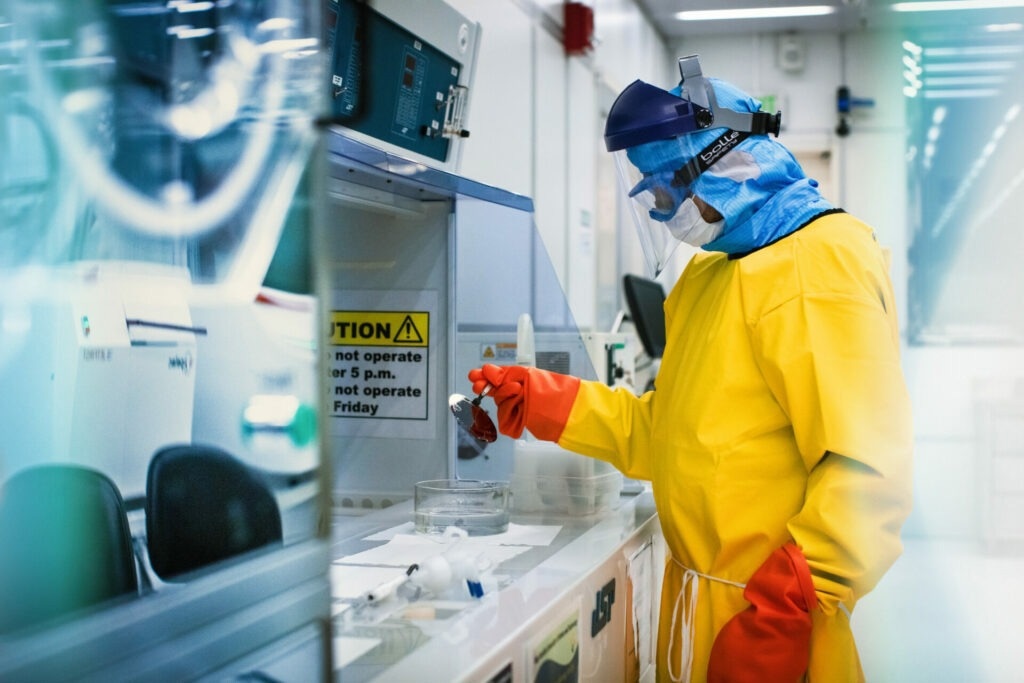
Dayanand Kumar prepared the memristor device in the King Abdullah University of Science and Technology’s specialized nanofabrication laboratory. Image Credit: 2023 King Abdullah University of Science & Technology; Anastasia Serin
Using the Nobel-Prize-winning technology of the charge-coupled device (CCD) image sensors discovered in early digital cameras, Dayanand Kumar, Nazek El-Atab, and co-workers have suited and improved the core structure of CCD to make light-sensitive memory devices that could be programmed by light.
In particular, the research group fixed the two-dimensional material MoS2 into a semiconductor capacitor (MOSCAP) structure that props the charge-storing pixels of a CCD sensor.
The resultant Al/Al2O3/MoS2/Al2O3/Si MOSCAP structures function as a charge-trapping “in-memory” sensor that is sensitive to visible light and could be programmed optically and erased electrically.
The in-memory light sensors are smart multifunctional memory devices that can perform the roles of multiple—traditionally discrete—devices at once, including optical sensing, storage, and computation.
Nazek El-Atab, Professor, King Abdullah University of Science and Technology
El-Atab added, “Our long-term goal is to be able to demonstrate in-memory sensors that can detect different stimuli and compute. This overcomes the memory wall and allows for faster and more real-time data analysis using reduced power consumption, which is a requirement in many futuristic and state-of-the-art applications such as Internet of Things, autonomous cars, and artificial intelligence, among others.”
Experiments performed with light with a wavelength anywhere from the blue to the red spectral region show that a photo-generated charge could be trapped or stored with an extremely long-lived retention time.
The consequent “memory window” voltage of >2V could be stored for up to a decade before being electrically erased by employing a +/–6V signal. Furthermore, it has the potential to be operated for several millions of cycles.
The study’s ultimate goal is to make a single optoelectronic device that could perform optical sensing and storage along with computing capabilities.
By integrating their MoS2 MOSCAP structure along with a neural network, the research group showed that it was possible to execute simple binary image recognition, successfully differentiating between images of either a dog or an automobile, with a precision of 91%.
Every image had a size of 32×32 pixels, and just the blue information from the images was extracted as that equals the peak sensitivity of the device.
Currently, the team would like to additionally develop the level of optical control.
Current memory devices can be programmed optically but require erasing electrically. In the future, we would like to explore in-memory optical sensors that can be fully optically operated.
Dayanand Kumar, Postdoc, King Abdullah University of Science and Technology
In relevant work, also on the topic of utilizing optoelectronics to execute tasks for artificial visual perception, the research group has explored the use of black phosphorus to make an optoelectronic memristive synapse that copies the neurons of the brain for neuromorphic computing applications.
Their multilayer device comprises a thin layer of hafnium oxide and black phosphorus that has been fixed between an upper layer of copper and a lower layer of platinum. It functions as an optoelectronic memristor—a resistor that has the potential to have its electrical resistance that has been programmed by visible light.
Experiments show that it provides highly stable synaptic features, like long-term depression (a long-lasting decrease in signal output), long-term potentiation (a long-term increase in signal output), and short-term plasticity (change in response over time), which are all known to be significant neuronal behaviors.
A 6×6 synaptic array from the devices was built by the team, and in the future, they believe that bigger arrays could assist in identifying a biomimetic retina. Significantly, the devices could be fabricated cost-efficiently by solution processing and are adaptable with stable operation having a bend radius of 1 cm. This sets the stage for wearable applications.
Smart in-memory light sensors perform image recognition
The electrical resistance of the optoelectric memristor can be programmed by visible light. Video Credit: 2023 King Abdullah University of Science & Technology; Anastasia Serin
Journal Reference
Kumar, D., et al. (2023) Artificial visual perception neural system using a solution-processable MoS2-based in-memory light sensor. Light: Science & Applications. doi.org/10.1038/s41377-023-01166-7.